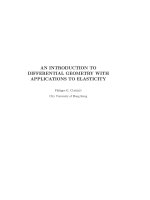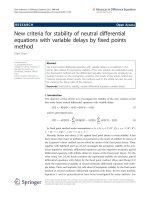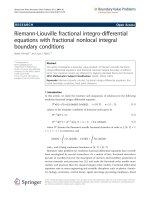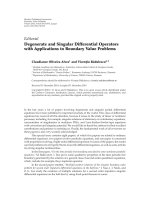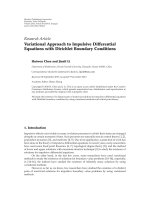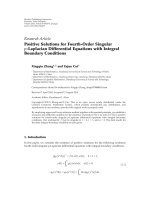Differential equations with applications and historical notes, third
Bạn đang xem bản rút gọn của tài liệu. Xem và tải ngay bản đầy đủ của tài liệu tại đây (4.65 MB, 763 trang )
DIFFERENTIAL EQUATIONS
WITH APPLICATIONS AND
HISTORICAL NOTES
Third Edition
www.pdfgrip.com
TEXTBOOKS in MATHEMATICS
Series Editors: Al Boggess and Ken Rosen
PUBLISHED TITLES
ABSTRACT ALGEBRA: AN INTERACTIVE APPROACH, SECOND EDITION
William Paulsen
ABSTRACT ALGEBRA: AN INQUIRY-BASED APPROACH
Jonathan K. Hodge, Steven Schlicker, and Ted Sundstrom
ADVANCED LINEAR ALGEBRA
Hugo Woerdeman
APPLIED ABSTRACT ALGEBRA WITH MAPLE™ AND MATLAB®, THIRD EDITION
Richard Klima, Neil Sigmon, and Ernest Stitzinger
APPLIED DIFFERENTIAL EQUATIONS: THE PRIMARY COURSE
Vladimir Dobrushkin
COMPUTATIONAL MATHEMATICS: MODELS, METHODS, AND ANALYSIS WITH MATLAB® AND MPI,
SECOND EDITION
Robert E. White
DIFFERENTIAL EQUATIONS: THEORY, TECHNIQUE, AND PRACTICE, SECOND EDITION
Steven G. Krantz
DIFFERENTIAL EQUATIONS: THEORY, TECHNIQUE, AND PRACTICE WITH BOUNDARY VALUE PROBLEMS
Steven G. Krantz
DIFFERENTIAL EQUATIONS WITH MATLAB®: EXPLORATION, APPLICATIONS, AND THEORY
Mark A. McKibben and Micah D. Webster
ELEMENTARY NUMBER THEORY
James S. Kraft and Lawrence C. Washington
EXPLORING LINEAR ALGEBRA: LABS AND PROJECTS WITH MATHEMATICA®
Crista Arangala
GRAPHS & DIGRAPHS, SIXTH EDITION
Gary Chartrand, Linda Lesniak, and Ping Zhang
INTRODUCTION TO ABSTRACT ALGEBRA, SECOND EDITION
Jonathan D. H. Smith
www.pdfgrip.com
TEXTBOOKS in MATHEMATICS
DIFFERENTIAL EQUATIONS
WITH APPLICATIONS AND
HISTORICAL NOTES
Third Edition
George F. Simmons
www.pdfgrip.com
CRC Press
Taylor & Francis Group
6000 Broken Sound Parkway NW, Suite 300
Boca Raton, FL 33487-2742
© 2017 by Taylor & Francis Group, LLC
CRC Press is an imprint of Taylor & Francis Group, an Informa business
No claim to original U.S. Government works
Printed on acid-free paper
Version Date: 20160815
International Standard Book Number-13: 978-1-4987-0259-1 (Hardback)
This book contains information obtained from authentic and highly regarded sources. Reasonable
efforts have been made to publish reliable data and information, but the author and publisher cannot
assume responsibility for the validity of all materials or the consequences of their use. The authors and
publishers have attempted to trace the copyright holders of all material reproduced in this publication
and apologize to copyright holders if permission to publish in this form has not been obtained. If any
copyright material has not been acknowledged please write and let us know so we may rectify in any
future reprint.
Except as permitted under U.S. Copyright Law, no part of this book may be reprinted, reproduced,
transmitted, or utilized in any form by any electronic, mechanical, or other means, now known or
hereafter invented, including photocopying, microfilming, and recording, or in any information storage or retrieval system, without written permission from the publishers.
For permission to photocopy or use material electronically from this work, please access www.copyright.com ( or contact the Copyright Clearance Center, Inc. (CCC), 222
Rosewood Drive, Danvers, MA 01923, 978-750-8400. CCC is a not-for-profit organization that provides licenses and registration for a variety of users. For organizations that have been granted a photocopy license by the CCC, a separate system of payment has been arranged.
Trademark Notice: Product or corporate names may be trademarks or registered trademarks, and are
used only for identification and explanation without intent to infringe.
Visit the Taylor & Francis Web site at
and the CRC Press Web site at
www.pdfgrip.com
For Hope and Nancy
my wife and daughter
who still make it all worthwhile
www.pdfgrip.com
www.pdfgrip.com
Contents
Preface to the Third Edition .................................................................................xi
Preface to the Second Edition ............................................................................ xiii
Preface to the First Edition...................................................................................xv
Suggestions for the Instructor ........................................................................... xix
About the Author ................................................................................................ xxi
1. The Nature of Differential Equations. Separable Equations ................ 1
1
Introduction ...........................................................................................1
2
General Remarks on Solutions ............................................................4
3
Families of Curves. Orthogonal Trajectories .................................. 11
4
Growth, Decay, Chemical Reactions, and Mixing.......................... 19
5
Falling Bodies and Other Motion Problems ................................... 31
6
The Brachistochrone. Fermat and the Bernoullis ........................... 40
Appendix A: Some Ideas From the Theory of Probability:
The Normal Distribution Curve (or Bell Curve) and
Its Differential Equation ................................................................................ 51
2. First Order Equations ..................................................................................65
7
Homogeneous Equations ...................................................................65
8
Exact Equations ................................................................................... 69
9
Integrating Factors .............................................................................. 74
10
Linear Equations ................................................................................. 81
11
Reduction of Order .............................................................................85
12
The Hanging Chain. Pursuit Curves ............................................... 88
13
Simple Electric Circuits ...................................................................... 95
3. Second Order Linear Equations............................................................... 107
14
Introduction ....................................................................................... 107
15
The General Solution of the Homogeneous Equation ................. 113
16
The Use of a Known Solution to find Another ............................. 119
17
The Homogeneous Equation with Constant Coefficients ........... 122
18
The Method of Undetermined Coefficients .................................. 127
19
The Method of Variation of Parameters......................................... 133
20
Vibrations in Mechanical and Electrical Systems ........................ 136
21
Newton’s Law of Gravitation and The Motion of the Planets ...... 146
22
Higher Order Linear Equations. Coupled
Harmonic Oscillators ....................................................................... 155
23
Operator Methods for Finding Particular Solutions.................... 161
Appendix A. Euler ....................................................................................... 170
Appendix B. Newton ................................................................................... 179
vii
www.pdfgrip.com
viii
Contents
4. Qualitative Properties of Solutions ........................................................ 187
24
Oscillations and the Sturm Separation Theorem ......................... 187
25
The Sturm Comparison Theorem ................................................... 194
5. Power Series Solutions and Special Functions..................................... 197
26
Introduction. A Review of Power Series ........................................ 197
27
Series Solutions of First Order Equations ...................................... 206
28
Second Order Linear Equations. Ordinary Points ....................... 210
29
Regular Singular Points ................................................................... 219
30
Regular Singular Points (Continued) ............................................. 229
31
Gauss’s Hypergeometric Equation ................................................. 236
32
The Point at Infinity .......................................................................... 242
Appendix A. Two Convergence Proofs .................................................... 246
Appendix B. Hermite Polynomials and Quantum Mechanics.............. 250
Appendix C. Gauss ...................................................................................... 262
Appendix D. Chebyshev Polynomials and the Minimax Property ...... 270
Appendix E. Riemann’s Equation ............................................................. 278
6. Fourier Series and Orthogonal Functions ............................................. 289
33
The Fourier Coefficients ................................................................... 289
34
The Problem of Convergence .......................................................... 301
35
Even and Odd Functions. Cosine and Sine Series ....................... 310
36
Extension to Arbitrary Intervals ..................................................... 319
37
Orthogonal Functions ...................................................................... 325
38
The Mean Convergence of Fourier Series ...................................... 336
Appendix A. A Pointwise Convergence Theorem ..................................345
7. Partial Differential Equations and Boundary Value Problems ........ 351
39
Introduction. Historical Remarks ................................................... 351
40
Eigenvalues, Eigenfunctions, and the Vibrating String .............. 355
41
The Heat Equation ............................................................................ 366
42
The Dirichlet Problem for a Circle. Poisson’s Integral ................. 372
43
Sturm–Liouville Problems ............................................................... 379
Appendix A. The Existence of Eigenvalues and Eigenfunctions .......... 388
8. Some Special Functions of Mathematical Physics .............................. 393
44
Legendre Polynomials ...................................................................... 393
45
Properties of Legendre Polynomials ..............................................400
46
Bessel Functions. The Gamma Function ....................................... 407
47
Properties of Bessel Functions ........................................................ 418
Appendix A. Legendre Polynomials and Potential Theory................... 427
Appendix B. Bessel Functions and the Vibrating Membrane................ 435
Appendix C. Additional Properties of Bessel Functions........................ 441
www.pdfgrip.com
ix
Contents
9. Laplace Transforms .................................................................................... 447
48
Introduction ....................................................................................... 447
49
A Few Remarks on the Theory ....................................................... 452
50
Applications to Differential Equations .......................................... 457
51
Derivatives and Integrals of Laplace Transforms ........................463
52
Convolutions and Abel’s Mechanical Problem ............................. 468
53
More about Convolutions. The Unit Step and
Impulse Functions ............................................................................ 475
Appendix A. Laplace ...................................................................................483
Appendix B. Abel .........................................................................................484
10. Systems of First Order Equations............................................................ 487
54
General Remarks on Systems .......................................................... 487
55
Linear Systems................................................................................... 491
56
Homogeneous Linear Systems with Constant Coefficients ........ 498
57
Nonlinear Systems. Volterra’s Prey-Predator Equations ............. 507
11. Nonlinear Equations .................................................................................. 513
58
Autonomous Systems. The Phase Plane and Its Phenomena ..... 513
59
Types of Critical Points. Stability .................................................... 519
60
Critical Points and Stability for Linear Systems ........................... 529
61
Stability By Liapunov’s Direct Method.......................................... 541
62
Simple Critical Points of Nonlinear Systems ................................ 547
63
Nonlinear Mechanics. Conservative Systems............................... 557
64
Periodic Solutions. The Poincaré–Bendixson Theorem............... 563
65
More about the van der Pol Equation............................................. 572
Appendix A. Poincaré ................................................................................. 574
Appendix B. Proof of Liénard’s Theorem ................................................ 576
12. The Calculus of Variations ....................................................................... 581
66
Introduction. Some Typical Problems of the Subject ................... 581
67
Euler’s Differential Equation for an Extremal .............................. 584
68
Isoperimetric Problems .................................................................... 595
Appendix A. Lagrange ................................................................................ 606
Appendix B. Hamilton’s Principle and Its Implications ........................ 608
13. The Existence and Uniqueness of Solutions ......................................... 621
69
The Method of Successive Approximations .................................. 621
70
Picard’s Theorem ............................................................................... 626
71
Systems. The Second Order Linear Equation ............................... 638
14. Numerical Methods ...................................................................................643
By John S. Robertson
72
Introduction .......................................................................................643
www.pdfgrip.com
x
Contents
73
74
75
76
77
The Method of Euler .........................................................................646
Errors ..................................................................................................650
An Improvement to Euler ................................................................ 652
Higher Order Methods..................................................................... 657
Systems ............................................................................................... 661
Numerical Tables ............................................................................................... 667
Answers ............................................................................................................... 681
Index ..................................................................................................................... 723
www.pdfgrip.com
Preface to the Third Edition
I have taken advantage of this new edition of my book on differential equations to add two batches of new material of independent interest:
First, a fairly substantial appendix at the end of Chapter 1 on the famous
bell curve. This curve is the graph of the normal distribution function, with many applications in the natural sciences, the social sciences,
mathematics—in statistics and probability theory—and engineering. We
shall be especially interested how the differential equation for this curve
arises from very simple considerations and can be solved to obtain the equation of the curve itself.
And second, a brief section on the van der Pol nonlinear equation and its
historical background in World War II that gave it significance in the development of the theory of radar. This consists, in part, of personal recollections
of the eminent physicist Freeman Dyson.
Finally, I should add a few words on the meaning of the cover design, for
this design amounts to a bit of self-indulgence.
The chapter on Fourier series is there mainly to provide machinery needed
for the following chapter on partial differential equations. However, one of
the minor offshoots of Fourier series is to find the exact sum of the infinite
series formed from the reciprocals of the squares of the positive integers
(the first formula on the cover). This sum was discovered by the great Swiss
mathematician Euler in 1736, and since his time, several other methods for
obtaining this sum, in addition to his own, have been discovered. This is one
of the topics dealt with in Sections 34 and 35 and has been one of my own
minor hobbies in mathematics for many years.
However, from 1736 to the present day, no one has ever been able to find
the exact sum of the reciprocals of the cubes of the positive integers (the second formula on the cover). Some years ago, I was working with the zeroes
of the Bessel functions. I thought for an exciting period of several days
that I was on the trail of this unknown sum, but in the end it did not work
out. Instead, the trail deviated in an unexpected direction and yielded yet
another method for finding the sum in the first formula. These ideas will be
found in Section 47.
xi
www.pdfgrip.com
www.pdfgrip.com
Preface to the Second Edition
“As correct as a second edition”—so goes the idiom. I certainly hope so, and
I also hope that anyone who detects an error will do me the kindness of letting me know, so that repairs can be made. As Confucius said, “A man who
makes a mistake and doesn’t correct it is making two mistakes.”
I now understand why second editions of textbooks are always longer
than first editions: as with governments and their budgets, there is always
strong pressure from lobbyists to put things in, but rarely pressure to take
things out.
The main changes in this new edition are as follows: the number of problems in the first part of the book has been more than doubled; there are
two new chapters, on Fourier Series and on Partial Differential Equations;
sections on higher order linear equations and operator methods have been
added to Chapter 3; and further material on convolutions and engineering
applications has been added to the chapter on Laplace Transforms.
Altogether, many different one-semester courses can be built on various
parts of this book by using the schematic outline of the chapters given on
page xix. There is even enough material here for a two-semester course, if the
appendices are taken into account.
Finally, an entirely new chapter on Numerical Methods (Chapter 14) has
been written especially for this edition by Major John S. Robertson of the
United States Military Academy. Major Robertson’s expertise in these matters is much greater than my own, and I am sure that many users of this new
edition will appreciate his contribution, as I do.
McGraw-Hill and I would like to thank the following reviewers for their
many helpful comments and suggestions: D. R. Arterburn, New Mexico
Tech; Edward Beckenstein, St. John’s University; Harold Carda, South Dakota
School of Mines and Technology; Wenxiong Chen, University of Arizona;
Jerald P. Dauer, University of Tennessee; Lester B. Fuller, Rochester Institute
of Technology; Juan Gatica, University of Iowa; Richard H. Herman, The
Pennsylvania State University; Roger H. Marty, Cleveland State University;
Jean-Pierre Meyer, The Johns Hopkins University; Krzysztof Ostaszewski,
University of Louisville; James L. Rovnyak, University of Virginia; Alan
Sharples, New Mexico Tech; Bernard Shiffman, The Johns Hopkins
University; and Calvin H. Wilcox, University of Utah.
George F. Simmons
xiii
www.pdfgrip.com
www.pdfgrip.com
Preface to the First Edition
To be worthy of serious attention, a new textbook on an old subject should
embody a definite and reasonable point of view which is not represented by
books already in print. Such a point of view inevitably reflects the experience, taste, and biases of the author, and should therefore be clearly stated at
the beginning so that those who disagree can seek nourishment elsewhere.
The structure and contents of this book express my personal opinions in a
variety of ways, as follows.
The place of differential equations in mathematics. Analysis has been the
dominant branch of mathematics for 300 years, and differential equations
are the heart of analysis. This subject is the natural goal of elementary calculus and the most important part of mathematics for understanding the
physical sciences. Also, in the deeper questions it generates, it is the source
of most of the ideas and theories which constitute higher analysis. Power
series, Fourier series, the gamma function and other special functions, integral equations, existence theorems, the need for rigorous justifications of
many analytic processes—all these themes arise in our work in their most
natural context. And at a later stage they provide the principal motivation
behind complex analysis, the theory of Fourier series and more general
orthogonal expansions, Lebesgue integration, metric spaces and Hilbert
spaces, and a host of other beautiful topics in modern mathematics. I would
argue, for example, that one of the main ideas of complex analysis is the
liberation of power series from the confining environment of the real number system; and this motive is most clearly felt by those who have tried to
use real power series to solve differential equations. In botany, it is obvious
that no one can fully appreciate the blossoms of flowering plants without
a reasonable understanding of the roots, stems, and leaves which nourish
and support them. The same principle is true in mathematics, but is often
neglected or forgotten.
Fads are as common in mathematics as in any other human activity,
and it is always difficult to separate the enduring from the ephemeral in
the achievements of one’s own time. At present there is a strong current
of abstraction flowing through our graduate schools of mathematics. This
current has scoured away many of the individual features of the landscape
and replaced them with the smooth, rounded boulders of general theories. When taken in moderation, these general theories are both useful and
satisfying; but one unfortunate effect of their predominance is that if a
student doesn’t learn a little while he is an undergraduate about such colorful and worthwhile topics as the wave equation, Gauss’s hypergeometric
function, the gamma function, and the basic problems of the calculus of
xv
www.pdfgrip.com
xvi
Preface to the First Edition
variations—among many others—then he is unlikely to do so later. The
natural place for an informal acquaintance with such ideas is a leisurely
introductory course on differential equations. Some of our current books
on this subject remind me of a sightseeing bus whose driver is so obsessed
with speeding along to meet a schedule that his passengers have little or
no opportunity to enjoy the scenery. Let us be late occasionally, and take
greater pleasure in the journey.
Applications. It is a truism that nothing is permanent except change; and
the primary purpose of differential equations is to serve as a tool for the
study of change in the physical world. A general book on the subject without
a reasonable account of its scientific applications would therefore be as futile
and pointless as a treatise on eggs that did not mention their reproductive
purpose. This book is constructed so that each chapter except the last has
at least one major “payoff”—and often several—in the form of a classic scientific problem which the methods of that chapter render accessible. These
applications include
The brachistochrone problem
The Einstein formula E = mc2
Newton’s law of gravitation
The wave equation for the vibrating string
The harmonic oscillator in quantum mechanics
Potential theory
The wave equation for the vibrating membrane
The prey–predator equations
Nonlinear mechanics
Hamilton’s principle
Abel’s mechanical problem
I consider the mathematical treatment of these problems to be among the
chief glories of Western civilization, and I hope the reader will agree.
The problem of mathematical rigor. On the heights of pure mathematics,
any argument that purports to be a proof must be capable of withstanding
the severest criticisms of skeptical experts. This is one of the rules of the
game, and if you wish to play you must abide by the rules. But this is not the
only game in town.
There are some parts of mathematics—perhaps number theory and abstract
algebra—in which high standards of rigorous proof may be appropriate at
all levels. But in elementary differential equations a narrow insistence on
doctrinaire exactitude tends to squeeze the juice out of the subject, so that
only the dry husk remains. My main purpose in this book is to help the
www.pdfgrip.com
xvii
Preface to the First Edition
student grasp the nature and significance of differential equations; and to
this end, I much prefer being occasionally imprecise but understandable to
being completely accurate but incomprehensible. I am not at all interested
in building a logically impeccable mathematical structure, in which definitions, theorems, and rigorous proofs are welded together into a formidable
barrier which the reader is challenged to penetrate.
In spite of these disclaimers, I do attempt a fairly rigorous discussion from
time to time, notably in Chapter 13 and Appendices A in Chapters 5, 6 and 7,
and B in Chapter 11. I am not saying that the rest of this book is nonrigorous,
but only that it leans toward the activist school of mathematics, whose primary aim is to develop methods for solving scientific problems—in contrast
to the contemplative school, which analyzes and organizes the ideas and
tools generated by the activists.
Some will think that a mathematical argument either is a proof or is not a
proof. In the context of elementary analysis I disagree, and believe instead
that the proper role of a proof is to carry reasonable conviction to one’s
intended audience. It seems to me that mathematical rigor is like clothing: in
its style it ought to suit the occasion, and it diminishes comfort and restricts
freedom of movement if it is either too loose or too tight.
History and biography. There is an old Armenian saying, “He who lacks
a sense of the past is condemned to live in the narrow darkness of his own
generation.” Mathematics without history is mathematics stripped of its
greatness: for, like the other arts—and mathematics is one of the supreme
arts of civilization—it derives its grandeur from the fact of being a human
creation.
In an age increasingly dominated by mass culture and bureaucratic impersonality, I take great pleasure in knowing that the vital ideas of mathematics were not printed out by a computer or voted through by a committee,
but instead were created by the solitary labor and individual genius of a
few remarkable men. The many biographical notes in this book reflect my
desire to convey something of the achievements and personal qualities of
these astonishing human beings. Most of the longer notes are placed in the
appendices, but each is linked directly to a specific contribution discussed
in the text. These notes have as their subjects all but a few of the greatest
mathematicians of the past three centuries: Fermat, Newton, the Bernoullis,
Euler, Lagrange, Laplace, Fourier, Gauss, Abel, Poisson, Dirichlet, Hamilton,
Liouville, Chebyshev, Hermite, Riemann, Minkowski, and Poincaré. As
T. S. Eliot wrote in one of his essays, “Someone said: ‘The dead writers are
remote from us because we know so much more than they did.’ Precisely, and
they are that which we know.”
History and biography are very complex, and I am painfully aware
that scarcely anything in my notes is actually quite as simple as it may
appear. I must also apologize for the many excessively brief allusions to
www.pdfgrip.com
xviii
Preface to the First Edition
mathematical ideas most student readers have not yet encountered. But
with the aid of a good library, sufficiently interested students should be
able to unravel most of them for themselves. At the very least, such efforts
may help to impart a feeling for the immense diversity of classical mathematics—an aspect of the subject that is almost invisible in the average
undergraduate curriculum.
George F. Simmons
www.pdfgrip.com
Suggestions for the Instructor
The following diagram gives the logical dependence of the chapters and suggests a variety of ways this book can be used, depending on the purposes
of the course, the tastes of the instructor, and the backgrounds and needs of
the students.
1. The nature of
differential
equations, separable
equations
2. First-order
equations
3. Second-order linear
equations
9. Laplace transforms
4. Qualitative
properties of
solutions
5. Power series
solutions and special
functions
12. The calculus of
variations
10. Systems of firstorder equations
11. Nonlinear equations
6. Fourier series and
orthogonal
functions
7. Partial differential
equations and
boundary value
problems
8. Some special
functions of
mathematical physics
13. Existence and
uniqueness
theorems
14. Numerical methods
xix
www.pdfgrip.com
xx
Suggestions for the Instructor
The scientist does not study nature because it is useful; he studies it because
he delights in it, and he delights in it because it is beautiful. If nature were not
beautiful, it would not be worth knowing, and if nature were not worth knowing,
life would not be worth living. Of course I do not here speak of that beauty that
strikes the senses, the beauty of qualities and appearances; not that I undervalue
such beauty, far from it, but it has nothing to do with science; I mean that profounder beauty which comes from the harmonious order of the parts, and which
a pure intelligence can grasp.
—Henri Poincaré
As a mathematical discipline travels far from its empirical source, or still more,
if it is a second or third generation only indirectly inspired by ideas coming from
“reality,“it is beset with very grave dangers. It becomes more and more purely
aestheticizing, more and more purely l’art pour l’art. This need not be bad, if
the field is surrounded by correlated subjects, which still have closer empirical
connections, or if the discipline is under the influence of men with an exceptionally well-developed taste. But there is a grave danger that the subject will
develop along the line of least resistance, that the stream, so far from its source,
will separate into a multitude of insignificant branches, and that the discipline
will become a disorganized mass of details and complexities. In other words, at a
great distance from its empirical source, or after much “abstract” inbreeding, a
mathematical subject is in danger of degeneration.
—John von Neumann
Just as deduction should be supplemented by intuition, so the impulse to progressive generalization must be tempered and balanced by respect and love for colorful detail. The individual problem should not be degraded to the rank of special
illustration of lofty general theories. In fact, general theories emerge from consideration of the specific, and they are meaningless if they do not serve to clarify and
order the more particularized substance below. The interplay between generality
and individuality, deduction and construction, logic and imagination—this is
the profound essence of live mathematics. Any one or another of these aspects of
mathematics can be at the center of a given achievement. In a far-reaching development all of them will be involved. Generally speaking, such a development will
start from the “concrete” ground, then discard ballast by abstraction and rise to
the lofty layers of thin air where navigation and observation are easy; after this
flight comes the crucial test of landing and reaching specific goals in the newly
surveyed low plains of individual “reality.” In brief, the flight into abstract generality must start from and return to the concrete and specific.
—Richard Courant
www.pdfgrip.com
About the Author
George Simmons has academic degrees from the California Institute of
Technology, the University of Chicago, and Yale University. He taught at several colleges and universities before joining the faculty of Colorado College
in 1962, where he is a Professor of Mathematics. He is also the author of
Introduction to Topology and Modern Analysis (McGraw-Hill, 1963), Precalculus
Mathematics in a Nutshell (Janson Publications, 1981), and Calculus with Analytic
Geometry (McGraw-Hill, 1985).
When not working or talking or eating or drinking or cooking, Professor
Simmons is likely to be traveling (Western and Southern Europe, Turkey,
Israel, Egypt, Russia, China, Southeast Asia), trout fishing (Rocky Mountain
states), playing pocket billiards, or reading (literature, history, biography and
autobiography, science, and enough thrillers to achieve enjoyment without
guilt).
xxi
www.pdfgrip.com
www.pdfgrip.com
Chapter 1
The Nature of Differential
Equations. Separable Equations
1 Introduction
An equation involving one dependent variable and its derivatives with
respect to one or more independent variables is called a differential equation.
Many of the general laws of nature—in physics, chemistry, biology, and
astronomy—find their most natural expression in the language of differential equations. Applications also abound in mathematics itself, especially in
geometry, and in engineering, economics, and many other fields of applied
science.
It is easy to understand the reason behind this broad utility of differential
equations. The reader will recall that if y = f(x) is a given function, then its
derivative dy/dx can be interpreted as the rate of change of y with respect
to x. In any natural process, the variables involved and their rates of change
are connected with one another by means of the basic scientific principles
that govern the process. When this connection is expressed in mathematical
symbols, the result is often a differential equation.
The following example may illuminate these remarks. According to
Newton’s second law of motion, the acceleration a of a body of mass m is
proportional to the total force F acting on it, with 1/m as the constant of proportionality, so that a = F/m or
ma = F.
(1)
Suppose, for instance, that a body of mass m falls freely under the influence
of gravity alone. In this case the only force acting on it is mg, where g is the
acceleration due to gravity.1 If y is the distance down to the body from some
fixed height, then its velocity v = dy/dt is the rate of change of position and its
acceleration a = dv/dt = d2y/dt2 is the rate of change of velocity. With this notation, (1) becomes
1
g can be considered constant on the surface of the earth in most applications, and is approximately 32 feet per second per second (or 980 centimeters per second per second).
1
www.pdfgrip.com
2
Differential Equations with Applications and Historical Notes
m
d2 y
= mg
dt 2
or
d2 y
= g.
dt 2
(2)
If we alter the situation by assuming that air exerts a resisting force proportional to the velocity, then the total force acting on the body is mg − k(dy/dt),
and (1) becomes
m
d2 y
dy
= mg - k .
2
dt
dt
(3)
Equations (2) and (3) are the differential equations that express the essential
attributes of the physical processes under consideration.
As further examples of differential equations, we list the following:
dy
= – ky;
dt
(4)
d2 y
= – ky;
dt 2
(5)
m
(1 - x 2 )
x2
2
dy
+ 2xy = e – x ;
dx
(6)
d2 y
dy
–5
+ 6 y = 0;
dx 2
dx
(7)
d2 y
dy
- 2x
+ p( p + 1)y = 0 ;
2
dx
dx
(8)
d2 y
dy
+x
+ ( x 2 - p 2 )y = 0 .
dx 2
dx
(9)
The dependent variable in each of these equations is y, and the independent
variable is either t or x. The letters k, m, and p represent constants. An ordinary
differential equation is one in which there is only one independent variable, so
that all the derivatives occurring in it are ordinary derivatives. Each of these
equations is ordinary. The order of a differential equation is the order of the
www.pdfgrip.com
